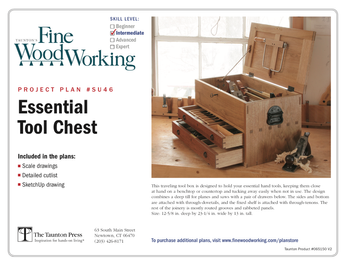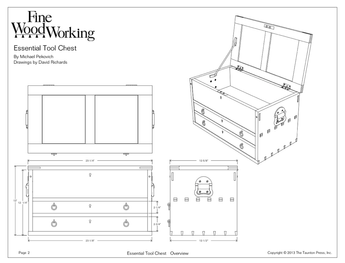I’m designing a built in dresser. Ill be using QS red oak for the drawer fronts. Is 10″ too deep for the drawers? Are the boards/parts too prone to excessive wood movement at this width?
Discussion Forum
Get It All!
UNLIMITED Membership is like taking a master class in woodworking for less than $10 a month.
Start Your Free TrialCategories
Discussion Forum
Digital Plans Library
Member exclusive! – Plans for everyone – from beginners to experts – right at your fingertips.
Highlights
-
Shape Your Skills
when you sign up for our emails
This site is protected by reCAPTCHA and the Google Privacy Policy and Terms of Service apply. -
 Shop Talk Live Podcast
Shop Talk Live Podcast -
 Our favorite articles and videos
Our favorite articles and videos -
E-Learning Courses from Fine Woodworking
-
-
 Fine Woodworking New England Event
Fine Woodworking New England Event -












Replies
Depends - if the drawers are dovetailed front and back, and you use quarter sawn stock for the sides, there's little if any chance that they will warp to the point where they'll stick and jam inside the case. Even if you don't have QS for the sides, 10" should be OK so long as the dovetails fit well.
Paul,
I've build a number of deep drawers, anything up to 15 inches deep. I've used DTs, finger joints and even a lockmitre joint to attach sides to the front/back.
If quarter-sawn stock for the sides is unavailable you can still use through & through or plainsawn without the drawers sticking. The trick is to use the NK system for attaching the bottoms, which gives a well-fitting drawer but avoids any chance of the sides sticking if they warp or bulge a little. The bottom runner provide the no-slop fit in the carcass so the drawer sides can be a millimetre or 3 from the carcass walls.
Here is the FWW article describing the technique:
http://www.taunton.com/finewoodworking/SkillsAndTechniques/SkillsAndTechniquesPDF.aspx?id=2730
Lataxe
I've built lots of drawers 10" and over (10" isn't all that deep, really) and have never had any problem with them. And I rarely use QS for the sides -- usually just plain sawn red oak or maple. I've never used any method other than DTs at all four corners (1/2 blind in front, or through with a seperate drawer front for kitchen cabs), with drawer bottoms in a normal groove, captured at the back or not, depending on the design of the rest of the cab.
The only issue is that you need to allow for the height of the drawer to increase a bit in humid weather, but that pretty much takes care of itself with normal drawer tolerances.
Mike Hennessy
Pittsburgh, PA
Thanks for the useful information. I'll most likely use a single board for the fronts and glued up soft maple for the sides and back. I'll use QS (or rift sawn) material for all the parts.
Are there any concerns with making some of the drawers 46" long x 10" deep for clothing?
Paul
Do you mean 46" wide? If so, you may wish to consider installing a center support under the bottom or making the bottom in two sections, like frame & panel. You may also wish to consider making the bottom captured at the back for additional support, but if you do, you need to make provisions so the back doesn't hang up on any side-to-side parts of your dust frame, etc.
Mike HennessyPittsburgh, PA
Thanks Mike,
I've got the drawers designed now at two vertical rows of 23 3/4" wide drawers. I just thought the design might be more appealing if the bottom drawer(s) were full width.
Thanks for the advice. I"ll be using Blum undermount slides.
Paul
Paul - a 46" wide drawer is definitely do-able, but I think you'll find that they don't operate very well without a center guide. Given a usual case width of 24", a 46" wide drawer has a tendency to want to jam against the side runners unless pulled out very carefully. This applies even with manufactured drawer slides, though the problem is a lot less of an issue than traditional wooden construction.
Paul C,
Several things come to mind , first check with the Blum specs and make sure the 46" width is within the specs for the slides secondly you seem to be concerned about the up and down movement in the drawer sides . Almost always the sides are not as tall as the front , this takes care of any drawer side problems , only the face fits the opening in height in many cases .
good luck dusty
Paul,
Nobody asked the question, so I guess I will. Do you mean 10" sides from one board or glued up stock to make 10" sides. I have 14" pots and pans drawers that are glued from maple stock. I usually keep my boards 4" or less and have never had a problem. I would very leery of a single board 10" side for a drawer. QS is the most stable but overkill in this situation.
If you follow the IDIOT guideline, you'll minimize drawer to case binding on any size drawer, as any movement is toward the inside of the drawer.
Inside of Drawer Is Outside Of Tree.
What an IDIOTic idea. I like it and will remember that!Chris @ http://www.flairwoodwork.spaces.live.com
- Success is not the key to happines. Happiness is the key to success. If you love what you are doing, you will be successful. - Albert Schweitzer
Many posts seem to focus on wood movement on a horizontal plane, i.e., worrying about whether the drawer will hit the sides of the cab. IMHO, that's not likely to be a problem, since the width is pretty much dictated by the front and back of the drawers, and since they are side-to-side grain, they don't move by any appreciable amount.
The main thing you need to be concerned with is expansion in the vertical plane, i.e., the distance between the bottoms of the drawer parts to the tops. Expansion in this dimension will cause the drawer to pinch top to bottom. QS will move less, but as I indicated in my prior post, 10" won't translate to a ton of movement. Normal clearance should suffice. Gluing the sides up out of multiple pieces will not help since the wood will move the same amount irrespective of the number of pieces it is made from.
For example, if you use white pine for the sides, at 10", the Shrinkulator indicates a width change of only .09" max for a change from 7% to 10% wood moisture. Just plan for that movement. If you make these drawers in the dry season, allow a bit of extra room for expansion. If you make 'em in the wet season, go ahead and fit them tightly.
Mike Hennessy
Pittsburgh, PA
This forum post is now archived. Commenting has been disabled